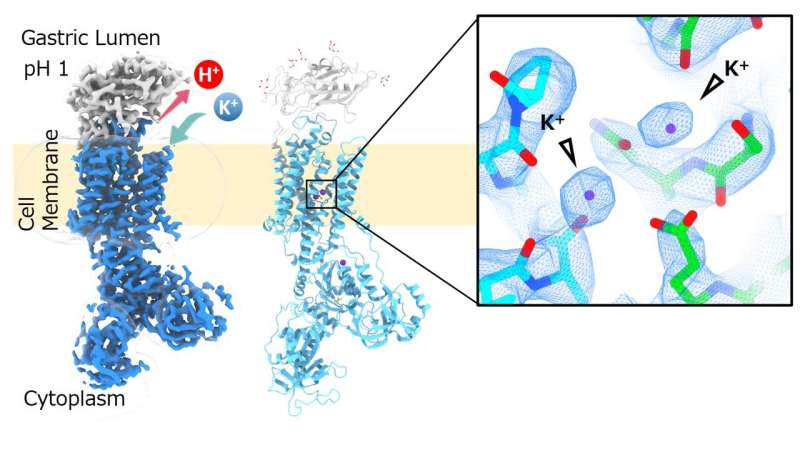Unique underpinnings revealed for stomach's acid pump

Nagoya University researchers and colleagues have improved understanding of the molecular mechanisms of a key protein that makes the stomach acidic. Their findings, published in the journal Nature Communications, could lead to better drugs for stomach ulcers and shed light on the functions of similar proteins across the human body."This gastric protein pumps in acidic ions to fortify our stomach, which is important for digestion but can sometimes lead to ulcers. Our results improve our understanding of how these types of proteins work, and we expect them to have further applications in drug development," says Kazuhiro Abe, a protein crystallographer at Nagoya University who led the research.
The H+/K+ ATPase protein is an enzyme that pumps hydrogen ions (H+) into the stomach to help digestion and kill any bugs we might swallow with our food and drink. However, excessive stomach acidification can lead to ulcers. Drugs that block the enzyme's activity could therefore reduce acidification and ease ulcer symptoms.
To design more effective drugs, scientists need to know how the protein works. In this study, the researchers demonstrated it has an unusual feature. To pump the hydrogen ions into the stomach, the protein first needs to bind to a potassium ion (K+). Similar proteins typically bind two such potassium ions to trigger the pump mechanism. But H+/K+ ATPase needs only one.
To investigate, the scientists fabricated novel versions of the protein. By adding five amino acids at specific locations, and then studying the new structure with a cryo-electron microscope, they fabricated a mutant form of H+/K+ ATPase that bound to two potassium ions.
The findings will help scientists understand why these important pump proteins bind to different numbers of ions. They can use that information to unpick the molecular mechanisms of similar proteins elsewhere.
"We have many cation [ion with a positive charge] pumps in our body. Sodium (Na+) pumps keep cells alive and drive signaling in the nervous system. Calcium (Ca+) pumps are vital for muscle contraction," Abe says. "Our strategy would be useful to investigate the cation selectivity for each cation pump, which is a central question for scientists working on the cation transport proteins."
More information: Kazuhiro Abe et al, Gastric proton pump with two occluded K+ engineered with sodium pump-mimetic mutations, Nature Communications (2021). DOI: 10.1038/s41467-021-26024-1
Journal information: Nature Communications
Provided by Nagoya University


















